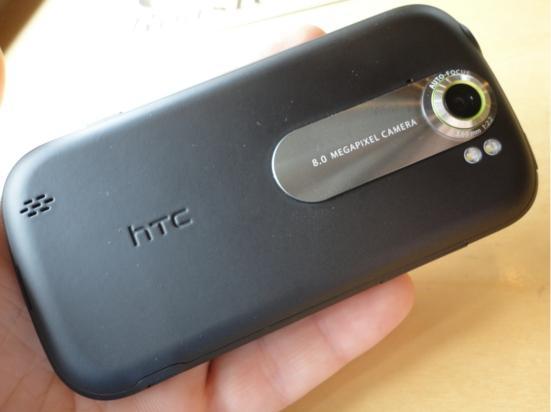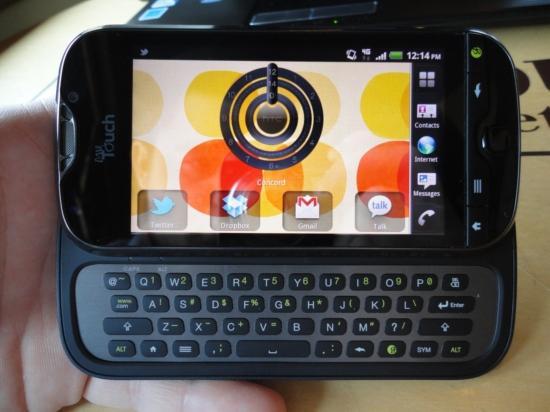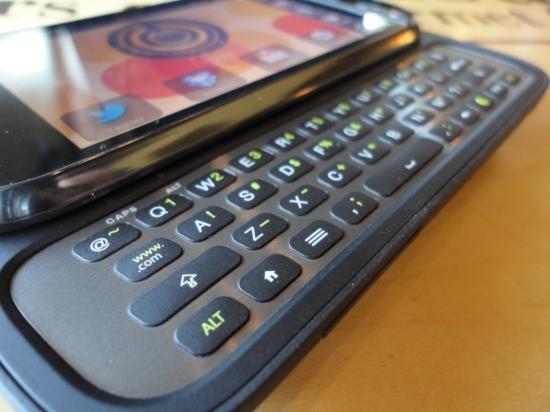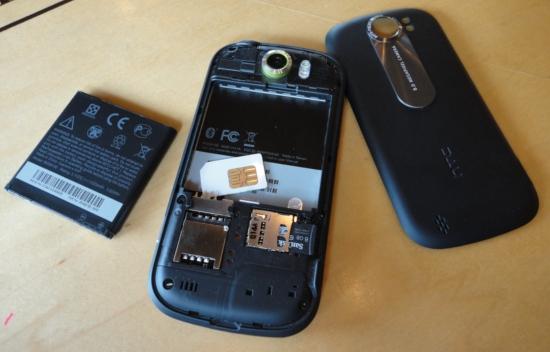
The myTouch 4G Slide is the newest entry in the popular myTouch line on T-Mobile's network and one of the more powerful phones to make its way to the probing hands of a PhoneDog reviewer. With a 3.7-inch S-LCD, 1.2GHz dual-core Snapdragon processor, advanced 8-megapixel rear shooter and horizontal QWERTY keyboard to boot, the myTouch 4G Slide will fit well in T-Mobile's diverse Android lineup.
Coming in two different flavors (khaki or black), the Slide can easily appeal to buyers looking to break from the drab world of black and gray phones and also business users looking for something a little more subtle. Available on July 27th for $199.99 with a two-year agreement, is the Slide worth the money? Or should you buy one of its slimmer QWERTY-less brethren instead?

If it weren't for the sliding QWERTY, the myTouch 4G Slide could easily be mistaken for its predecessor, the myTouch 4G. The face of the device holds a VGA front-facing camera, a very familiar looking speaker grill, five physical buttons (home, menu, back, Genius, optical trackpad) and a 3.7-inch S-LCD display. Much like the myTouch 4G, the outer trim of the face is a dark chrome, metallic band – something I've had trouble with scratching and denting with ease. Alone on the right edge of the phone is the dedicated two-step camera button; the left edge holds the volume rocker and the standard microUSB port. The power button and 3.5mm headphone jack are located on the top edge, and a lanyard hole is on the bottom. The back consists of a rubberized plastic battery door and an 8-megapixel camera (capable of 1080p video recording) with dual-LED flash.
I find the build quality of the myTouch 4G Slide is excellent. Unlike the myTouch 4G, the physical buttons on the face of the device do not squeak. I'm not a fan of physical Android buttons, but these aren't too terribly bad. I'm not sure why the optical trackpad made the cut on this device, though. The metal battery door of the myTouch 4G has been swapped for a rubberized plastic door, which I found to be sort of flimsy, but it's a non-issue and feels pretty sturdy when actually on the device. In hand, the Slide feels very solid with a comfortable weight to it. The sliding hinge is a little loose for my taste (especially after using the tight hinge on the DROID 3) and I fear it may loosen even more over time. That said, there is little to no movement when the keyboard is out or tucked in.
The minor improvements found on the Slide are a welcomed change, but nothing to write home about. I wish the style had changed a little more from the previous myTouch; the older design easily takes from the device's shine.

As it should, the myTouch 4G Slide ships with the latest version of Gingerbread, version 2.3.4, paired with HTC's popular Sense 3.0 interface. Unlike the Sensation, however, the Slide is equipped with the myTouch specific Espresso version of Sense – it comes with different wallpapers, Themes and a slightly different look from the standard issue Sense. Until recently, I have been a huge fan of Sense UI, but the more I deal with custom interfaces, the more I like vanilla Android. That said, Espresso adds a nice touch that return Sense users and newcomers alike should find refreshing.
I have been using the Slide as my personal device for the past few days. I made a few calls from several different locations to test the waters. The earpiece speaker quality has been crisp and very clear and I had no complaints from my call victims about any problems with hearing me either. I did experience a little choppiness during one of my calls, but it cleared up as I moved to a stronger coverage area. I switched to speakerphone mid-call and had no trouble hearing the person on the other end, but they did complain about it sounding like I was in a tunnel. Signal strength has also been great. Side by side with the G2x, the two devices have consistently displayed roughly the same signal strength in all areas, give or take a bar.
As depicted in the name, the myTouch 4G Slide is a HSPA+ enabled device. I've been running random speed tests throughout my trial with the phone and I've been pretty disappointed with data speeds. Running several tests (using different servers) from different locations, the Slide's 4G speeds have consistently been about 2-3Mbps slower than the G2x. The most I could muster out of the Slide was 3.5Mbps down and about 1.15Mbps up (the G2x has averaged around 6Mbps down and 1.2Mbps up). I'm not sure what the deal is here, let's just hope this is a software issue that can be resolved with an update.

The slide-out QWERTY keyboard is one of the noteworthy features of the myTouch 4G Slide. It is named the Slide for a reason. Being such an important selling feature of the phone, I honestly expected much more out of the keyboard. I've been typing on it quite a bit without a hitch, but there is little to no tactile feedback (the keys are mushy rather than stiff), and the island style keys are almost too far apart (they could stand to be bigger). This makes comfortably navigating the keyboard without looking more difficult than it should be. Also, the keyboard is slightly inset. The spacebar is very close to the raised lip, causing me to struggle with fully depressing the spacebar on the first try. On the other hand, the dedicated "www." (or ".com") button is a nice touch for the web browser.
If you were to pop open the hood of the myTouch 4G slide, you would find a 1.2GHz dual-core Snapdragon processor and 768MB of RAM that makes the phone absolutely fly. Like I mentioned in my First Impressions, I did initially experience some lag, but that was mostly due to the gauntlet of a stress test (downloading all of my apps and running multiple applications at once). Since initial setup, I've had no problems with any lag whatsoever. Not even the resource intensive Sense UI was enough to slow down the Slide, which says a lot. It is worth noting that several recent Sense-equipped devices have become victims of lag over a period of time.

Many smartphones nowadays (Sensation, Atrix, DROID 3, X2, etc.) are shipping with qHD displays at 960 by 540 pixels. The Slide only comes with a standard resolution (480 by 800 pixels) S-LCD display. I'm no display buff, by any stretch of the term, and I personally find resolution less important than color saturation and brightness (at this point). I have no complaints when it comes to the appearance of the display. Brightness, color reproduction and contrast are great. Unsurprisingly, I did have some trouble viewing the display in direct sunlight, even with brightness turned all the way up. My only complaint with the display on the Slide is the size. Apart from the iPhone (which I also wish had a bigger display), I've been using nothing but 4-inch displays or larger. With the aid of a half-decent keyboard for typing, the drop to 3.7-inches isn't so bad, but this phone with a 4-inch display would have been outstanding.
The most hyped feature of the myTouch 4G Slide is the camera, and rightly so. I had heard good things about this phone's camera before I ever received my unit, but I was skeptical. It is claimed that the Slide is equipped with the most advanced camera technology found in any smartphone to date, and I am now a believer. Pictures are extremely crisp, contrast and white balance are spot-on and the software is jam-packed with features. Seeing as I love to take Macro shots, I have really taken to that feature, but there are several other options like SweepShot (panoramic shots), ClearShot HDR, Burst, Action, etc. Auto-focus was somewhat slow to adjust at times, but the Slide touts zero shutter lag. Upon pressing the button, the shutter fires instantly, which I love. HD (1080p) video quality has also been quite impressive, despite lacking some in the audio department.
Battery life constantly seems to be my biggest complaint with the numerous Android phones I test. The Slide, however, has been reasonably impressive with its 1520 mAh battery. I charged it up and unplugged it the night before a full day away from the charger. Spending the day taking pictures, texting, tweeting and uploading pictures, Facebooking and browsing the web, I had no trouble making it through the day with a little extra juice to spare. It doesn't quite match that of the DROID 3's mind-blowing standby time or my CDMA iPhone, but consider me impressed.

When I first received the myTouch 4G Slide in the mail, I honestly didn't know what to think. I've been disinterested in it since I first saw the leaked images. I grew tired of the myTouch 4G fairly quickly, and on the design front, the myTouch 4G Slide is pretty bland and dated. But after unboxing it and giving it a chance, I have really warmed up to it. Although the physical keyboard could be much better, it isn't the worst QWERTY I've had to use. The camera is absolutely fantastic and battery life is a considerable improvement over some earlier Andoird devices. For $199.99 with a two-year agreement, the myTouch 4G Slide is a great device and will fit in quite well in T-Mobile's device lineup. That said, power users and spec-hungry buyers will be more prone to take the Sensation route.
What's Good: Battery life is decent; little to no lag with a 1.2GHz dual-core processor and 768MB RAM; build quality is great; the 8-megapixel camera is feature-filled and takes awesome shots; ships with Gingerbread and Espresso version of Sense 3.0; dedicated camera button.
What's Bad: Data speeds are lacking; the rehashed design is old and boring; the keys on the QWERTY keyboard are too spaced out and mushy; the sliding hinge is a little loose and may loosen even more over time.
The Verdict: Despite some hiccups with data speeds and a lackluster keyboard, the myTouch 4G Slide is a great device for the price and an excellent addition to T-Mobile's myTouch line. The camera and battery life are, by far, the two biggest selling points, but amongst phones like the Sensation 4G and G2x, the Slide may be easily overlooked and underestimated.